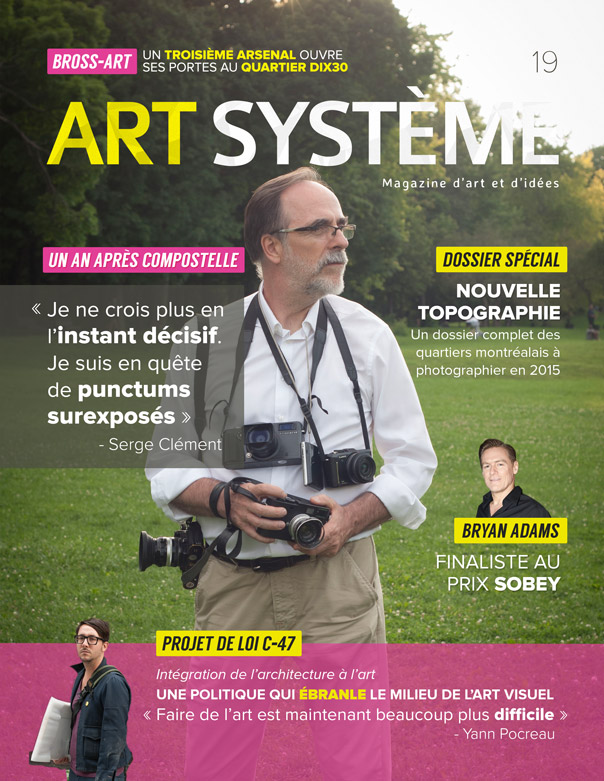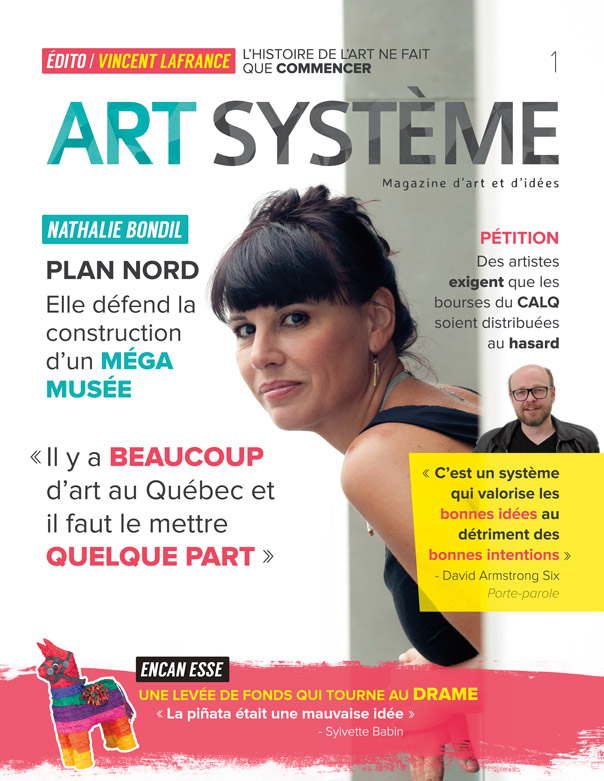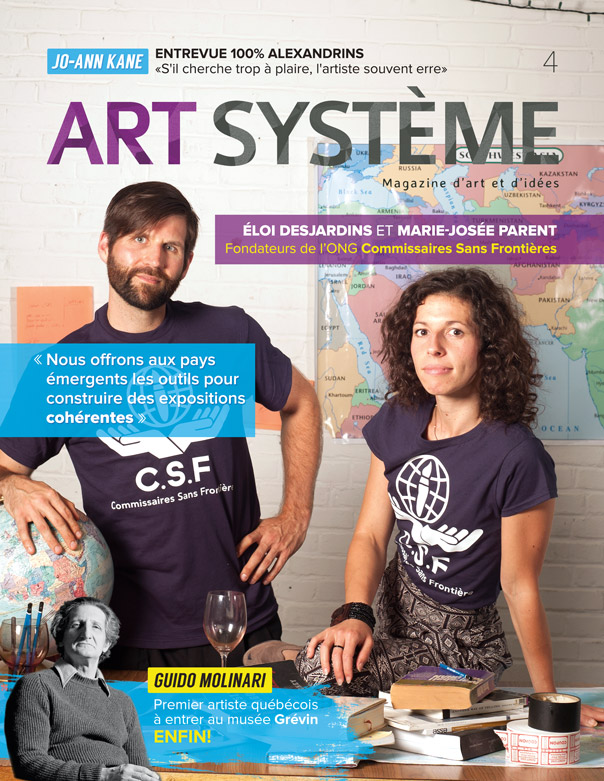[Winter 2015]
Vincent Lafrance’s work is permeated with the idea of the simulacrum perception and its faults. Playing with photographic virtuosity and with randomness, he composes visual illusions with traditional photographic means. His body of videographic work uses language as a confusing effect; he produces fictions that fluidly meander between tragedy and comedy. Lafrance holds a bachelor’s degree in photography from Concordia University. His work has been presented in Canada and Europe.
Jacques Doyon: You present the artwork that was in the recent exhibition at the Les Territoires gallery, Art Système. Magazine d’art et d’idées, as an exploration of our expectations regarding the art magazine by reminding us, in the press release, that A. A. Bronson considered such magazines the conjunctive tissue of the contemporary art scene. In this show, you challenge the image that the art community has of itself with a series of thirty-two covers of an imaginary magazine in which the personalities and certain issues in the field are transposed, as caricatures that are often frankly funny, in the attention-grabbing conduct of the general press. In this, I see a commentary in broad strokes on the trends already at work in the specialized press and in a more “serious” media community. Do these observations seem relevant to you? Could you elaborate on these issues?
Vincent Lafrance: I’m not sure that Art Système reflects a trend already at work in our media reality. I do observe, however, our common desire to exist a bit more. Of course, we have put art everywhere: in office towers, in the subway, in parks, at the beach, in hospitals, and even on former battlefields. But are we less invisible? Or rather, are we satisfied with this relative invisibility? Just as artists aspire to be recognized in their community, this same community seeks, in its turn, to be recognized in another, bigger and more powerful, community. Art Système fits within the fissures of this riposte and can be read as an anticipatory magazine in the dystopian genre. Formally, it results from the merger of the specialized art magazine and the less-specialized art magazine, such as Ricardo or Clin d’œil. The terminology is often equivalent: Marie-Claude Landry invites us to her country home to admit to us that she has learned to love herself. In another issue, Mathieu Beauséjour returns to fashion! These clichés of the popular press seem incompatible with our world, and yet it is difficult to evade the aura of print media. These garishly colourful titles have a strange magnetism. This effect interests me very directly; I find it captivating. Art Système is an imaginary magazine become nightmare. Paradoxically, some of us might wish that it did exist – if only to detest it.
JD: It is interesting that you connect the desire for greater visibility in a larger and more “powerful” circle to the notion of dystopia, thus evoking the sense of fascination and fear that the community feels about the danger of being subsumed in the mass consumer world. Even more so because your dash of humour is emphatic: you don’t spare us any of the psycho-pop sketches or the marketing of consumption and lifestyle trends. In fact, it gives me the shivers . . . Is this really what some part of the community hopes for? And can we truly consider Ricardo and Clin d’œil art magazines, even less-specialized ones? The models that served as a reference for the earlier magazines File and Interview seemed to be at a completely different level.
VL: Without wishing for a shift into English-style media, it seems obvious and observable to me that our community is looking for other forms of validation. A gala and a TV show are not incompatible with our community, and all of that seems positive to me. Of course, I don’t want a real Art Système to exist. Answering your questions is already difficult enough. Nor would I want to be photographed with a soft-ice-cream cone or, worse, to talk to you about my latest break-up. Unless you insist, Jacques.
Art Système enables me, through my own sins of taste, to talk about trends that I don’t like and vocabulary that irritates me.
The line is thin between specialized art magazine, non-specialized art magazine, and less-specialized art magazine. We have to keep in mind that Art Système is more closely related to the French magazine Hara-Kiri than to File or Interview. I represent our community with a certain arrogance, without praise or sycophancy. Art Système is not there to serve an art community. The project does not seem to have been conceived from a love of art; in fact, art seems to be absent from it. Twice this week, I’ve heard comments about the McCarthy Christmas tree on the radio, and, as is often the case, the artist’s name wasn’t mentioned. Art Système does the reverse: the individual is a subject of interest in itself. And this editorial posture is disturbing. The writing is complex: true criticism, false criticism, a real search for beauty in the texts, and an outra- geous demonstration of stupidity.
JD: What exactly is this “art system,” which serves as the title of the project but, in fact, is not really clarified here, except in the mode of riposte or contradiction? In fact, we are brought back to the grassroots and literally swallowed up by a media culture of video clips and shock formula and facile irony. Even so, we still laugh out loud at the situations and certain parodic features. But what are the ideas underlying this dystopian project? Has “the average Quebecer really come to confuse art and its opposite”?
VL: No: “The average Quebecer confuses the desire to be an artist with the desire to be on TV.” I didn’t say that; I think Didier Lucien did.
Art Système is an ideal instrument. It enables me, through my own sins of taste, to talk about trends that I don’t like and vocabulary that irritates me. People are represented with derision and affection. The magazine enables me to invent stories, and this type of creation is at the centre of my practice. I like the evocative power of text and image. It’s very simple and very direct: our mind goes half the distance, and at this very precise moment we laugh at our own fiction. It’s a very personal project, and to speak I use the voices of people I like. So, it’s an unfaithful portrait of my friends, my community. Art Système has the quality and the flaw of being a joke among friends.
JD: In addition to being obviously funny, Art Système stands out, it seems to me, for being symptomatic of the mood of the times. But it may also have the flaw of sticking a bit too closely to this simple observation, perhaps even adding a little, or at least playing on a certain ambiguity. Here, I’m betraying my point of view. A gala, imbued with humour, is what it says it is; similarly, a TV reality show, even one that manages to avoid the worst pitfalls of the genre, takes place in a media field that has already alienated us. But for some of us, the print press, especially magazines, remain a space for reflection, if not a field of resistance. At least, it’s from this angle that I want to grasp the pole that you hold out to us with this work.
At times, however, you point – perhaps more in the early issues – toward some very real concerns: that of the supposed overproduction of art (which was recently written about in the media), which you combine with the expansion of museums and the taking into account of different cultures (minority or international), which you connect with NGO culture, around the fiction of the paternalistic organization Commissaires sans frontières (CSF; Curators Without Borders). Grants from the Conseil des arts et des lettres du Québec being handed out at random, artists being experts on themselves, and 64 percent of regional art made in the city are all ripostes that address various questions related to the art field. And then there’s the inevitable allusion to “artist- run centres, not as well run as all that.” All of this is based on use of paradox and contradiction that potentially opens fields for thought that nevertheless come up a bit short, because they get lost in the mass of cheesiness. In short, I might have liked to see you flesh these ideas out a bit more.
VL: Flesh them out? I wouldn’t want to do that. That’s not the role of a headline. The headlines must be more interesting than the articles that don’t exist. What is complex and stimulating when we read the thirty-two covers is precisely this mixture of potentially interesting and absurd ideas. Art Sysème is punctuated with relatively profound and sometimes critical moments that are lost in a mass of nonsense. But this strategy stimulates me, and I’ve always kept it in mind when I work directly with humour. This mode of expression has the quality of not announcing its intention. In another register, Sophie Jodoin states in Art Système, “You have to know how to catch ideas that fall from heaven, because they don’t bounce.” This kind of vaguely profound formulation interests me. It is then up to the reader to figure out, among the 135 jokes in Art Système, the ones that evoke a broader dimension or a more legitimate idea. Translated by Käthe Roth





